Gavin Newsom
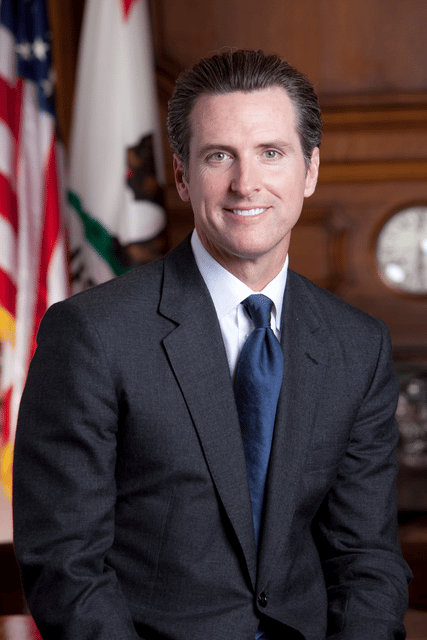
Gavin Newsom

Gavin Newsom | |
|---|---|
| 40th Governor of California | |
| Assumed office January 7, 2019 | |
| Lieutenant | Eleni Kounalakis |
| Preceded by | Jerry Brown |
| 49th Lieutenant Governor of California | |
| In office January 10, 2011 – January 7, 2019 | |
| Governor | Jerry Brown |
| Preceded by | Abel Maldonado |
| Succeeded by | Eleni Kounalakis |
| 42nd Mayor of San Francisco | |
| In office January 8, 2004 – January 10, 2011 | |
| Preceded by | Willie Brown |
| Succeeded by | Ed Lee |
| Member of the San Francisco Board of Supervisors from the 2nd district | |
| In office January 8, 1997 – January 8, 2004 | |
| Preceded by | Kevin Shelley |
| Succeeded by | Michela Alioto-Pier |
| Personal details | |
| Born | Gavin Christopher Newsom (1967-10-10)October 10, 1967 San Francisco, California, U.S. |
| Political party | Democratic |
| Spouse(s) | Jennifer Siebel (m. 2008) |
| Children | 4 |
| Father | William Newsom |
| Residence | Governor's Mansion (public) Fair Oaks, California (private) |
| Education | Santa Clara University (BS) |
| Signature | |
| Website | Governor website [131] |
Gavin Christopher Newsom (born October 10, 1967) is an American politician and businessman who is the 40th governor of California, serving since January 2019. A member of the Democratic Party, he previously served as the 49th lieutenant governor of California from 2011 to 2019 and as the 42nd mayor of San Francisco from 2004 to 2011. He was sworn in as Governor of California on January 7, 2019.[1]
Newsom attended Redwood High School, and graduated from Santa Clara University. After graduation, he founded the PlumpJack wine store with family friend Gordon Getty as an investor. The PlumpJack Group grew to manage 23 businesses, including wineries, restaurants, and hotels. Newsom began his political career in 1996, when San Francisco Mayor Willie Brown appointed him to serve on the city's Parking and Traffic Commission. Brown appointed Newsom to fill a vacancy on the Board of Supervisors the following year, and Newsom was later elected to the Board in 1998, 2000, and 2002.
In 2003, Newsom was elected the 42nd mayor of San Francisco, becoming the city's youngest mayor in a century.[2] Newsom was re-elected in 2007 with 72 percent of the vote.[3][4] He was elected Lieutenant Governor of California in 2010 as the running mate of Jerry Brown, and was re-elected in 2014.[5] In February 2015, Newsom announced his candidacy for Governor of California in the 2018 election.[6] On June 5, 2018, he finished in the top two of the non-partisan blanket primary.[7] Newsom defeated Republican John H. Cox in the general election on November 6.
Newsom hosted The Gavin Newsom Show on Current TV and wrote the 2013 book Citizenville.[8]
Gavin Newsom | |
|---|---|
| 40th Governor of California | |
| Assumed office January 7, 2019 | |
| Lieutenant | Eleni Kounalakis |
| Preceded by | Jerry Brown |
| 49th Lieutenant Governor of California | |
| In office January 10, 2011 – January 7, 2019 | |
| Governor | Jerry Brown |
| Preceded by | Abel Maldonado |
| Succeeded by | Eleni Kounalakis |
| 42nd Mayor of San Francisco | |
| In office January 8, 2004 – January 10, 2011 | |
| Preceded by | Willie Brown |
| Succeeded by | Ed Lee |
| Member of the San Francisco Board of Supervisors from the 2nd district | |
| In office January 8, 1997 – January 8, 2004 | |
| Preceded by | Kevin Shelley |
| Succeeded by | Michela Alioto-Pier |
| Personal details | |
| Born | Gavin Christopher Newsom (1967-10-10)October 10, 1967 San Francisco, California, U.S. |
| Political party | Democratic |
| Spouse(s) | Jennifer Siebel (m. 2008) |
| Children | 4 |
| Father | William Newsom |
| Residence | Governor's Mansion (public) Fair Oaks, California (private) |
| Education | Santa Clara University (BS) |
| Signature | |
| Website | Governor website [131] |
Early life
Gavin Christopher Newsom was born in San Francisco, California, to Tessa Thomas (née Menzies) and William Alfred Newsom III, a state appeals court justice and attorney for Getty Oil. He is a fourth-generation San Franciscan. His father was of mostly Irish descent; one of Newsom's maternal great-grandfathers, Scotsman Thomas Addis, was a pioneer scientist in the field of nephrology and a professor of medicine at Stanford University. Newsom is the second cousin, twice removed, of musician Joanna Newsom.[9]
His father was an advocate for otters and the family had one as a pet.[10] Newsom's parents separated when he was two, and divorced in 1972. At age ten, Newsom moved with his mother and sister to nearby Marin County.
While Newsom later reflected that he did not have an easy childhood,[11] he attended kindergarten and first grade at the French American bilingual school in San Francisco. He eventually transferred because of severe dyslexia that still affects him. His dyslexia has made it difficult for him to write, spell, read and work with numbers.[11]
He attended third through fifth grades at Notre Dame des Victoires, where he was placed in remedial reading classes. In high school, Newsom played basketball and baseball and graduated from Redwood High School in 1985. Newsom was an outfielder in baseball and his baseball skills placed him on the cover of the Marin Independent Journal.[12]
Tessa Newsom worked three jobs to support Gavin and his sister Hilary Newsom Callan, who is the president of the PlumpJack Group, named after the opera Plump Jack composed by family friend Gordon Getty. In an interview with The San Francisco Chronicle, his sister recalled Christmas holidays when their mother told them there wouldn't be any gifts.[12] Tessa opened their home to foster children, instilling in Newsom the importance of public service.[12][13] His father's finances were strapped in part because of his tendency to give away his earnings.[13] Newsom worked several jobs in high school to help support his family.[3]
Newsom attended Santa Clara University on a partial baseball scholarship, where he graduated in 1989 with a B.S. in political science. Newsom was a left-handed pitcher for Santa Clara, but he threw his arm out after two years and hasn't thrown a baseball since.[14] He lived in the Alameda Apartments, which he later compared to living in a hotel. He later reflected on his education fondly, crediting the Jesuit approach of Santa Clara that he said has helped him become an independent thinker who questions orthodoxy. While in school, Newsom spent a semester studying abroad in Rome.[15]
Newsom's aunt was married to Ron Pelosi, the brother-in-law of Speaker of the United States House of Representatives Nancy Pelosi.[11]
Business career
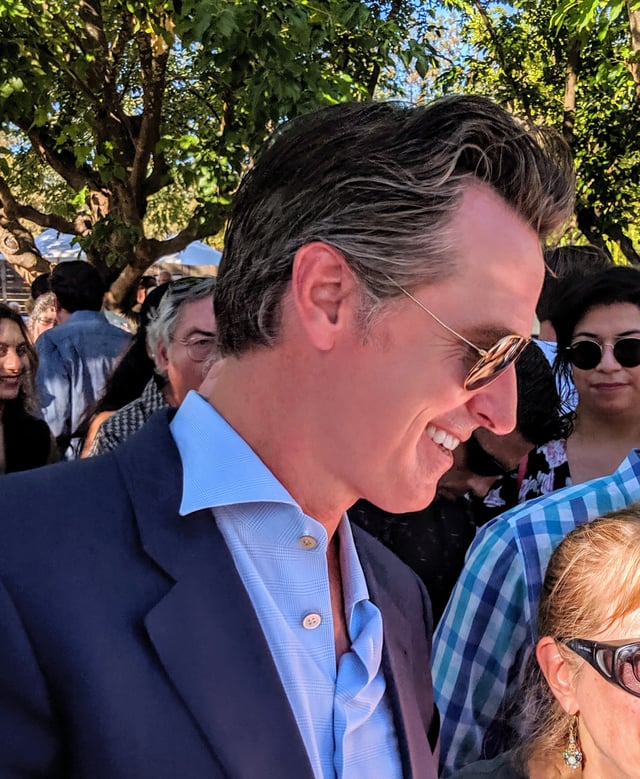
Newsom at a political event in the Napa Valley in 2019
On May 14, 1991, Newsom and his investors created the company PlumpJack Associates L.P. In 1992, the group started the PlumpJack Winery with the financial help[16] of his family friend Gordon Getty. PlumpJack was the name of an opera written by Getty, who invested in 10 of Newsom's 11 businesses.[11] Getty told the San Francisco Chronicle that he treated Newsom like a son and invested in his first business venture because of that relationship. According to Getty, later business investments were because of "the success of the first".[11]
One of Newsom's early interactions with government occurred when Newsom resisted the San Francisco Health Department requirement to install a sink at his PlumpJack wine store. The Health Department argued that wine was a food and required the store to install a $27,000 sink in the carpeted wine shop on the grounds that the shop needed the sink for a mop. When Newsom was later appointed supervisor, he told the San Francisco Examiner: "That's the kind of bureaucratic malaise I'm going to be working through."[14]
The business grew to an enterprise with more than 700 employees.[12] The PlumpJack Cafe Partners L.P. opened the PlumpJack Café, also on Fillmore Street, in 1993. Between 1993 and 2000, Newsom and his investors opened several other businesses that included the PlumpJack Squaw Valley Inn with a PlumpJack Café (1994), a winery in Napa Valley (1995), the Balboa Café Bar and Grill (1995), the PlumpJack Development Fund L.P. (1996), the MatrixFillmore Bar (1998), PlumpJack Wines shop Noe Valley branch (1999), PlumpJackSport retail clothing (2000), and a second Balboa Café at Squaw Valley (2000).[11] Newsom's investments included five restaurants and two retail clothing stores.[12] Newsom's annual income was greater than $429,000 from 1996 to 2001.[11] In 2002, his business holdings were valued at more than $6.9 million.[12] Newsom gave a monthly $50 gift certificate to PlumpJack employees whose business ideas failed, because in his view, "There can be no success without failure."[14]
Newsom sold his share of his San Francisco businesses when he became mayor in 2004. He maintained his ownership in the PlumpJack companies outside San Francisco that included the PlumpJack Winery in Oakville, California, new PlumpJack-owned Cade Winery in Angwin, California, and the PlumpJack Squaw Valley Inn. He is currently the president in absentia of Airelle Wines Inc., which is connected to the PlumpJack Winery in Napa County. Newsom earned between $141,000 and $251,000 in 2007 from his business interests.[17] In February 2006, he paid $2,350,000 for his residence in the Russian Hill neighborhood, which he put on the market in April 2009, for $3,000,000.[18]
Early political career
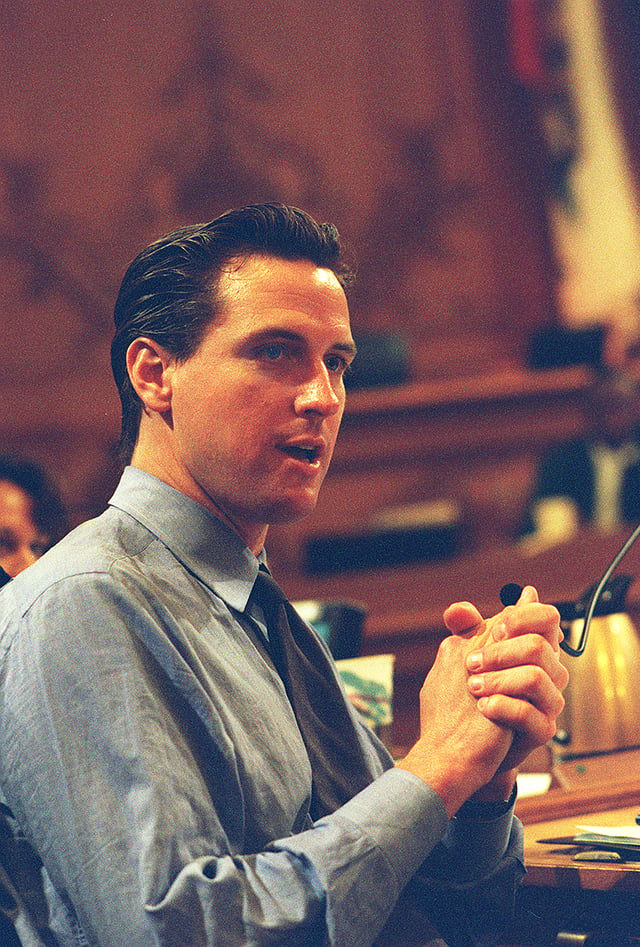
Newsom in 1999
Newsom's first political experience came when he volunteered for Willie Brown's successful campaign for mayor in 1995. Newsom hosted a private fundraiser at his PlumpJack Café.[11] In 1996, Brown appointed Newsom to a vacant seat on the Parking and Traffic Commission, and he was later elected president of the commission. In 1997, Brown appointed him to the San Francisco Board of Supervisors seat vacated by Kevin Shelley. At the time, he became the youngest member of San Francisco's board of supervisors and also, like Shelley before him, the board's only white heterosexual male.[19][20][21]
Newsom was sworn in by his father and pledged to bring his business experience to the board.[20] Brown called Newsom "part of the future generation of leaders of this great city".[20] Newsom described himself as a "social liberal and a fiscal watchdog".[20][21] Newsom was subsequently elected to a full four-year term to the board in 1998. In 1999, San Francisco's voters chose to exchange at-large elections to the board for the previous district system, and Newsom was re-elected in 2000 and in 2002 to represent the second district, which includes the Pacific Heights, Marina, Cow Hollow, Sea Cliff, and Laurel Heights. He faced no opposition in his 2002 re-election. His district had the highest income level and the highest Republican registration in San Francisco.[22] In 2000, Newsom paid $500 to the San Francisco Republican Party to be on the party's endorsement slate.
As a San Francisco Supervisor, Newsom gained public attention for his role in advocating reform of the city's Municipal Railway ("Muni").[23] He was one of two supervisors endorsed by Rescue Muni, a transit riders group, in his 1998 re-election. He sponsored Proposition B to require Muni and other city departments to develop detailed customer service plans.[11][24] The measure passed with 56.6% of the vote.[25] Newsom sponsored a ballot measure from Rescue Muni; a version of the measure was approved by voters in November 1999.[23]
Newsom also supported allowing restaurants to serve alcohol at their outdoor tables, banning tobacco advertisements visible from the streets, stiffer penalties for landlords, and a resolution to commend Colin Powell for raising money for youth programs that was defeated.[23] Newsom's support for business interests at times strained his relationship with labor leaders.[23]
During Newsom's time as supervisor, he supported housing projects through public–private partnerships to increase homeownership and affordable housing in San Francisco.[26] Newsom supported HOPE, a failed local ballot measure that would have allowed an increased condo-conversion rate if a certain percentage of tenants within a building were buying their units. As a candidate for mayor, he supported building 10,000 new housing units to create 15,000 new construction jobs.[26]
As supervisor, Newsom had as his centerpiece a voter initiative called Care Not Cash (Measure N), which offered care, supportive housing, drug treatment, and help from behavioral health specialists for the homeless in lieu of direct cash aid from the state's general assistance program.[26] Many homeless rights advocates protested against the initiative.[27][28] The successfully passed ballot measure raised the political profile of Gavin Newsom and provided the volunteers, donors, and campaign staff that helped make him a leading contender for the mayorship in 2003.[11][29][30]
Mayor of San Francisco
2003 election
Newsom placed first in the November 4, 2003, general election in a nine-person field. Newsom received 41.9 percent of the vote to Green Party candidate Matt Gonzalez's 19.6 in the first round of balloting, but he faced a closer race in the December 9 run-off when many of the city's progressive groups coalesced around Gonzalez.[29] The race was partisan with attacks against Gonzalez for his support of Ralph Nader in the 2000 presidential election, and attacks against Newsom for contributing $500 to a Republican slate mailer in 2000 that endorsed issues Newsom supported.[31][32] Democratic leadership felt that they needed to reinforce San Francisco as a Democratic stronghold after losing the 2000 presidential election and the 2003 recall election to Arnold Schwarzenegger.[32] National figures from the Democratic Party, including Bill Clinton, Al Gore, and Jesse Jackson, campaigned on Newsom's behalf.[32][33] Five supervisors endorsed Gonzalez, while Newsom received the endorsement of Willie Brown.[29][30]
Newsom won the run-off race, capturing 53 percent of the vote to Gonzalez's 47 percent and winning by 11,000 votes.[29] Newsom ran as a business-friendly centrist Democrat and a moderate in San Francisco politics; some of his opponents called him conservative.[29][32] Newsom claimed he was a centrist in the Dianne Feinstein mold.[26][34] He ran on the slogan "great cities, great ideas", and presented over 21 policy papers.[30] He pledged to continue working on San Francisco's homelessness issue.[29]
Newsom was sworn in as mayor on January 3, 2004. He called for unity among the city's political factions, and promised to address the issues of potholes, public schools, and affordable housing.[35] Newsom said he was "a different kind of leader" who "isn't afraid to solve even the toughest problems".[36]
2007 election
San Francisco's progressive community attempted to find a candidate to run a strong campaign against Newsom. Supervisors Ross Mirkarimi and Chris Daly considered running against Newsom, but both declined. Matt Gonzalez also decided not to challenge Newsom.[37]
When the August 10, 2007, filing deadline passed, the discussion around San Francisco shifted to talk about Newsom's second term. He was challenged in the election by 13 candidates that included George Davis, a nudist activist, and Michael Powers, owner of the Power Exchange sex club.[38] Conservative former supervisor Tony Hall withdrew by early September due to lack of support.[39]
The San Francisco Chronicle declared in August 2007 that Newsom faced no "serious threat to his re-election bid", having raised $1.6 million for his re-election campaign by early August.[40] He won re-election on November 6, 2007 with over 72% of the vote.[4] Upon taking office for a second term, Newsom promised to focus on the environment, homelessness, health care, education, housing, and rebuilding San Francisco General Hospital.[41][42]
Mayoralty
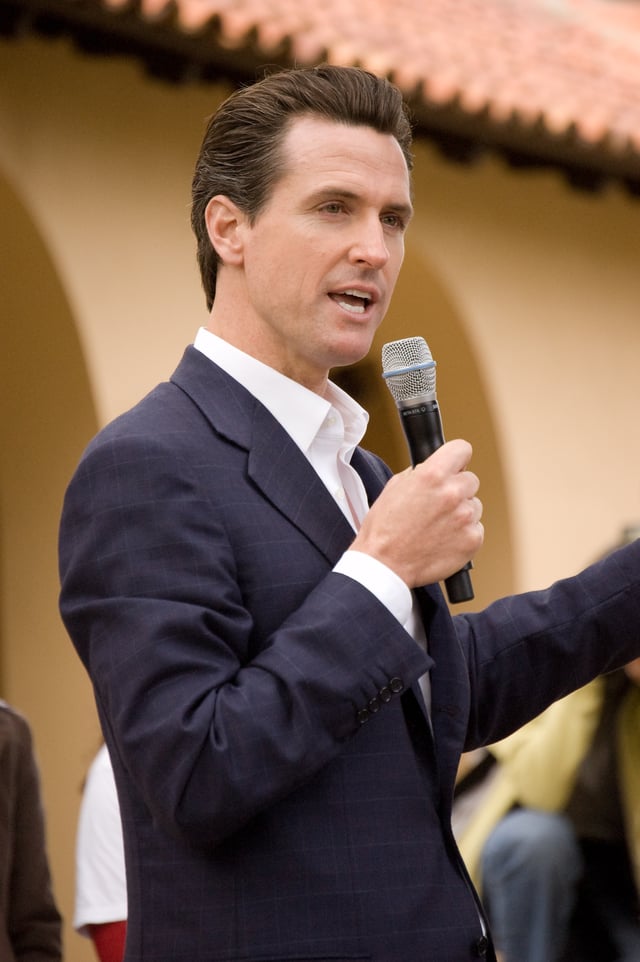
Newsom at Stanford University in 2008
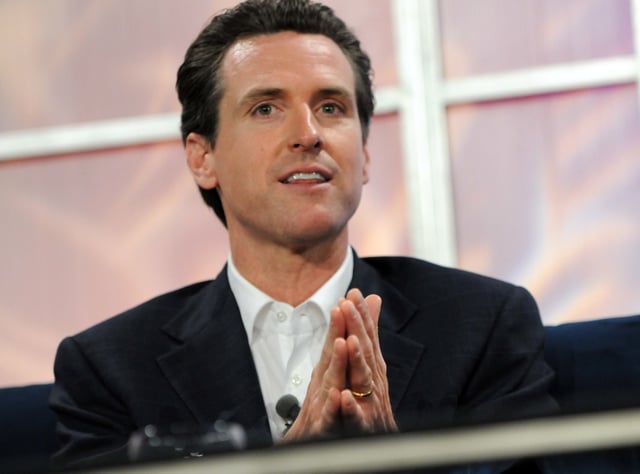
Gavin Newsom at the 2008 Web 2.0 Summit
As mayor, Newsom focused on development projects in Hunters Point and Treasure Island. He signed the Healthy San Francisco Plan in 2007 to provide San Francisco residents with universal health care. In 2004, Newsom gained national attention when he directed the San Francisco city–county clerk to issue marriage licenses to same-sex couples, in violation of the state law passed in 2000.[43]
Implementation of Care Not Cash began on July 1, 2004. As part of his Care Not Cash initiative, 5,000 more homeless people were given permanent shelter in the city. As of October 21, 2007, about 2,000 people have been placed into permanent housing with support. Other programs initiated by Newsom to end chronic homelessness include the San Francisco Homeless Outreach Team (SF HOT), and Project Homeless Connect (PHC). On October 27, 2004, during a strike by hotel workers on a dozen San Francisco hotels, Newsom joined UNITE HERE union members on a picket line in front of the Westin St. Francis Hotel. He vowed that the city would boycott the hotels by not sponsoring city events in any until the hotels agreed to a contract with workers. The contract dispute was settled in September 2006.[44]
In 2005, Newsom pushed for a state law to allow communities in California to create policy restricting certain breeds of dogs.[45]
In 2009, Newsom came under attack from the San Francisco Democratic Party for his failure to implement the City of San Francisco's sanctuary city rule, under which the city was to not assist U.S. Immigration and Customs Enforcement.[46]
In 2009, Newsom received the Leadership for Healthy Communities Award, along with Mayor Michael Bloomberg of New York City and three other public officials, for his commitment to making healthful food and physical activity options more accessible to children and families.[47] In 2008, he had hosted the Urban Rural Roundtable to explore ways to promote regional food development and increased access to healthy affordable food,[48] and he secured $8 million in federal and local funds for the Better Streets program,[49] which ensures that public health perspectives are fully integrated into urban planning processes. He signed a menu-labeling bill into law, requiring that chain restaurants print nutrition information on their menus.[50] In 2010, Newsom was named "America's Most Social Mayor" by Samepoint, based on analysis of the social media profiles of mayors from the 100 largest cities in the United States.[51]
Same-sex marriage
In 2004, Newsom gained national attention when he directed the San Francisco city–county clerk to issue marriage licenses to same-sex couples, in violation of the then-current state law.[43] In August 2004, the Supreme Court of California annulled the marriages that Newsom had authorized, as they conflicted with state law at that time. Still, Newsom's unexpected move brought national attention to the issues of gay marriage, solidifying political support for Newsom in San Francisco and in the LGBTQ+ community.[3][13][52]
During the 2008 election, Newsom was a prominent and vocal opponent of Proposition 8, the ballot initiative to reverse the California Supreme Court ruling that there was a constitutional right to same-sex marriage.[53] Proposition 8 supporters released a commercial featuring footage of Newsom saying the following in a speech regarding same-sex marriage: "This door's wide open now. It's going to happen, whether you like it or not."[54] Some observers noted that polls shifted in favor of Proposition 8 following the release of the commercial; this, in turn, led to speculation that Newsom had inadvertently played a role in the passage of the amendment.[54][55][56][57]
Lieutenant Governor of California
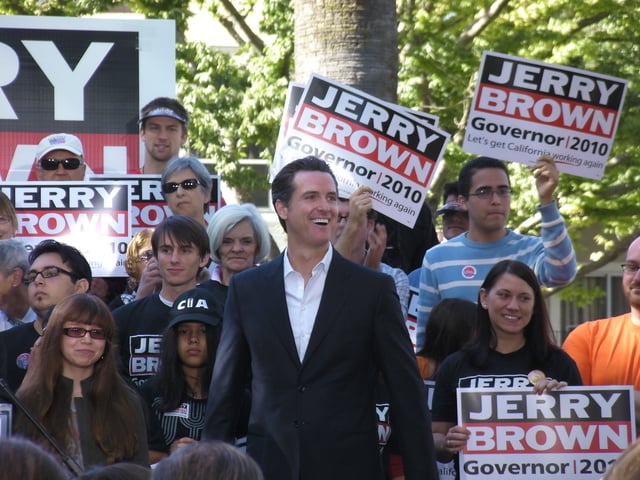
Gavin Newsom at a Jerry Brown campaign event, 2010
In April 2009, Newsom announced his intention to run for Governor of California in the 2010 election. In September 2009, he received the endorsement of former president Bill Clinton. During the campaign, Newsom remarked that, if elected, he'd like to be referred to as "The Gavinator" (a reference to Governor Arnold Schwarzenegger's nickname, "The Governator"). Throughout the campaign, however, Newsom suffered low poll numbers, trailing Democratic frontrunner Jerry Brown by more than 20 points in most polls.[58][59][60][61][62][63] In October 2009, Newsom dropped out of the gubernatorial race.[64][65][66]
In February 2010, Newsom filed initial paperwork to run for lieutenant governor,[67] and officially announced his candidacy in March.[5] He received the Democratic nomination in June,[68] and won the election on November 2, 2010.[69] Newsom was sworn in as lieutenant governor on January 10, 2011. The one-week delay was to ensure that a successor as mayor of San Francisco was chosen before he left office. Edwin M. Lee, the city administrator, took office the day after Newsom was sworn in as lieutenant governor. In May 2012, he debuted on Current TV as the host of The Gavin Newsom Show. In 2012, Newsom drew criticism for his negative view of California's state capital Sacramento.[70]
On November 4, 2014, Newsom was re-elected as Lieutenant Governor of California, defeating Republican Ron Nehring with 57.2% of the vote. His second term began on January 5, 2015, the same date when Governor Brown was sworn in for a second term after his re-election.[71]
Technology in government
Newsom released his first book, Citizenville: How to Take the Town Square Digital and Reinvent Government, on February 7, 2013.[72][73] The book discusses the Gov 2.0 movement that is taking place across the United States. Following the release of Citizenville, Newsom began to work with the Center for Information Technology Research in the Interest of Society at the University of California, Berkeley, on the California Report Card (CRC).[74] The CRC is a mobile-optimized platform that allows California residents to "grade" their state on six timely issues. The CRC exemplifies ideas presented in Newsom's Citizenville, encouraging direct public involvement in government affairs via modern technology.[75]
In 2015, Newsom partnered with the Institute for Advanced Technology and Public Policy at California Polytechnic State University to launch Digital Democracy, an online tool that uses facial and voice recognition to enable users to navigate California legislative proceedings.[76]
Education
In November 2015, Newsom joined then-Long Beach City College Superintendent Eloy Oakley in an op-ed calling for the creation of the California College Promise, which would create partnerships between public schools, public universities and employers and offer a free community college education.[77] Throughout 2016, Newsom joined Oakland Mayor Libby Schaaf at the launch of the Oakland Promise and then-Second Lady Jill Biden and LA Mayor Eric Garcetti at the launch of the LA Promise.[78][79] In June 2016, the Lieutenant Governor helped secure $15 million in the state budget to support the creation of promise programs throughout the state.[80]
In December 2015, Newsom called on the University of California to reclassify computer science courses as a core academic class in order to incentivize more high schools to offer computer science curriculum.[81][82] Newsom sponsored successful legislation signed by Governor Brown in September 2016, that began the planning process for expanding computer science education to all California students, beginning as early as kindergarten.[83]
In 2016, the Lieutenant Governor passed a series of reforms at the University of California to provide student-athletes with additional academic and injury-related support, and to ensure that contracts for athletic directors and coaches emphasized academic progress. This came in response to several athletics programs, including the University of California – Berkeley's football team, which garnered the lowest graduation rates in the country.[84][85]
Cannabis legalization
In 2014, Newsom was the only statewide politician to endorse California Proposition 47, a piece of legislation that decriminalized nonviolent offenses like drug and property crimes, turning them into misdemeanors as opposed to felonies. The measure was passed by voters in the state of California on November 4, 2014.[86]
In July 2015, Newsom released the final report of the Blue Ribbon Commission on Marijuana Policy, which he had convened with the American Civil Liberties Union of California in 2013. The report's recommendations to regulate marijuana were intended to inform a legalization measure on the November 2016 ballot.[87] Newsom supported the resulting measure, Proposition 64, which legalized cannabis use and cultivation for California state residents who are 21 or older.[88]
In response to pro-enforcement statements made by Press Secretary Sean Spicer, Newsom sent a letter on February 24, 2017, to Attorney General Sessions and President Trump, urging them not to increase federal enforcement against recreational cannabis firms opening up in California.[88] He wrote, "The government must not strip the legal and publicly supported industry of its business and hand it back to drug cartels and criminals ... Dealers don't card kids. I urge you and your administration to work in partnership with California and the other eight states that have legalized recreational marijuana for adult use in a way that will let us enforce our state laws that protect the public and our children, while targeting the bad actors." Newsom responded to comments by Spicer which compared cannabis to opioids saying, "Unlike marijuana, opioids represent an addictive and harmful substance, and I would welcome your administration's focused efforts on tackling this particular public health crisis."[88]
Capital punishment
Newsom supported a failed measure in 2012 that sought to end capital punishment in California. He claimed the initiative would save California millions of dollars, citing statistics that California had spent $5 billion since 1978 to execute just 13 people.[89]
Newsom also supported failed Proposition 62 in 2016, which also would have repealed the death penalty in California.[86] He argued that Prop 62 would get rid of a system "that is administered with troubling racial disparities". He also stated that the death penalty was fundamentally immoral and did not deter crime.[89]
Governor of California
On February 11, 2015, Newsom announced that he was opening a campaign account for governor in the 2018 elections, allowing him to raise funds for a campaign to succeed Jerry Brown as Governor of California.[6] On June 5, 2018, he finished in the top two of the nonpartisan blanket primary, and defeated Republican John H. Cox by a landslide in the gubernatorial election on November 6.[7]
Newsom was sworn in on January 7, 2019.
Capital punishment
On March 13, 2019, Newsom announced that he ordered a moratorium on the state's death penalty, preventing any execution in the state as long as he was still in office as governor. The move also led to the withdrawal of the state's current lethal injection protocol and the closure of the execution chamber at San Quentin State Prison.[90] In a CBS This Morning interview, Newsom stated that the death penalty was "a racist system. You cannot deny that." He also stated that it was "a system that is perpetuating inequality. It's a system that I cannot in good conscience support."[91]
Gavin Newsom is against the death penalty and has issued a moratorium on all executions which granted a temporary reprieve for the 737 inmates on the state's death row, the largest in the Western Hemisphere.[92]
Clemency
In response to the Trump's administration crackdown immigrants with criminal records, he has given heightened consideration to people in this situation.[93] In his first acts of clemency as Governor, he pardoned seven formerly incarcerated people in May 2019, including two Cambodian refugees facing deportation.[94] A pardon can eliminate the grounds for deportation of immigrants who are legal permanent residents. Pardon requests from people facing deportation are provided with an expedited review by the state Board of Parole Hearings per a 2018 California law.[93]
Gun control
As Lieutenant Governor in 2016, he was the official proponent of Proposition 63. The ballot measure required a background check and California Department of Justice authorization to purchase ammunition among other gun control regulations. In response to the 2019 mass shooting in Virginia Beach, he called for nationwide background checks on people purchasing ammunition.[95] Later that year, he responded to the Gilroy Garlic Festival shooting with, "Tonight, CA stands with the Gilroy community." "Grateful for the law enforcement's efforts and their continues work as this situation develops."[96] He visited with survivors and the families of victims. While stating his support for the 2nd Amendment, he said he would like national cooperation controlling "weapons of goddamned mass destruction".[97]
Health care
Reducing the cost of health care and increasing access in California were priorities he campaigned on. He also supported creating a universal health care system in California.[98] The budget passed in June 2019 addressed these priorities by expanding eligibility for Medi-Cal to undocumented youth ages 19 to 25. The state's health program for the poor already includes eligibility for those 18 and younger but California will become the first state to expand eligibility to undocumented young adults.[98]
Housing shortage
In his first week of office, Newsom threatened to withhold state funding for infrastructure to communities that failed to take actions to alleviate California's housing shortage.[99][100] In late January 2019, he announced that he would sue Huntington Beach for preventing the construction of affordable housing.[101] Newsom has been characterized as an opponent of NIMBY (not-in-my-back-yard) sentiment.[102][103][104]
Travel
He chose El Salvador as his first international trip as governor.[105] With nearly 680,000 Salvadoran immigrants living in California, he felt that the "state's relationship with Central America is key to California's future".[106] He was also concerned about the tens of thousands of Salvadorans that were fleeing the smallest country in Central America for the U.S. each year.[107] As governor of a state impacted by the debate of illegal immigration, he went to see first-hand the factors driving it and to build business and tourism partnerships between California and Central America. He said he wanted to “ignite a more enlightened engagement and dialogue.”[108]
Electoral history
Personal life
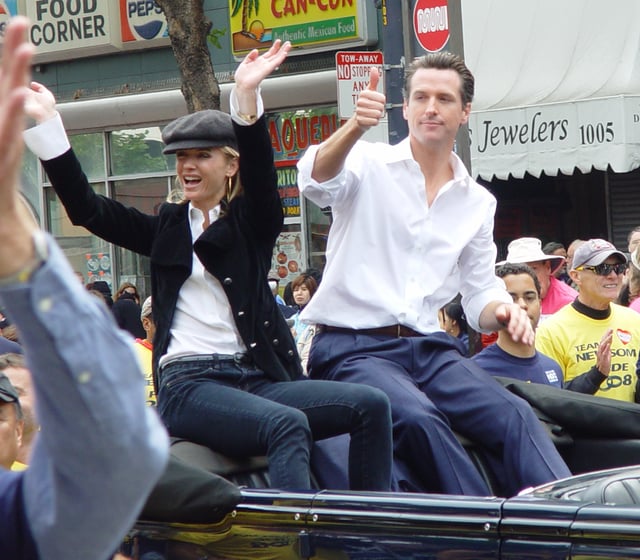
Newsom with then-fiancée Jennifer Siebel at the 2008 San Francisco Pride parade
Newsom was baptized and reared in his father's Roman Catholic faith. He describes himself as an "Irish Catholic rebel [...] in some respects, but one that still has tremendous admiration for the Church and very strong faith". When asked about the current state of the Catholic Church, he said the church was in crisis.[15] Newsom said he stays with the Church because of his "strong connection to a greater purpose, and [...] higher being [...]" Newsom identifies himself as a practicing Catholic,[109] stating that he has a "strong sense of faith that is perennial: day in and day out".[15]
In December 2001, Newsom married Kimberly Guilfoyle, a former San Francisco prosecutor and legal commentator for Court TV, CNN, and MSNBC who later became a prominent personality on Fox News Channel. The couple married at Saint Ignatius Catholic Church on the campus of the University of San Francisco, where Guilfoyle attended law school. The couple appeared in the September 2004 issue of Harper's Bazaar, a fashion magazine, in a spread of them at the Getty Villa with the title the "New Kennedys".[3][110] In January 2005, they jointly filed for divorce, citing "difficulties due to their careers on opposite coasts".[111] Their divorce was finalized on February 28, 2006.[112]
In 2005, Newsom was selected as a Young Global Leader by the World Economic Forum.[113]
In January 2007, it was revealed that Newsom had had a romantic relationship in mid-2005 with Ruby Rippey-Tourk, the wife of his then campaign manager and former deputy chief of staff, Alex Tourk.[114][115] Tourk filed for divorce shortly after the revelation and left Newsom's campaign and administration. Newsom's affair with Rippey-Tourk impacted his popularity with male voters, who viewed the adultery as a betrayal of a close friend and ally.[116]
In September 2006, Newsom began dating film director Jennifer Siebel. In February 2007, he announced he would seek treatment for alcohol abuse.[117] In December 2007, Newsom and Siebel announced their engagement,[118][119] and they were married in Stevensville, Montana in July 2008.[120] In September 2009, Siebel gave birth to a girl, Montana Tessa Newsom.[121] Siebel gave birth to a son, Hunter Siebel Newsom, on June 12, 2011, their daughter Brooklynn on July 3, 2013,[122] and on February 26, 2016, the Newsoms announced the birth of second son, Dutch.[123]
In 2012, Newsom and his family moved out of San Francisco and bought a house in Kentfield, California, in Marin County.[124]
See also
Electoral history of Gavin Newsom